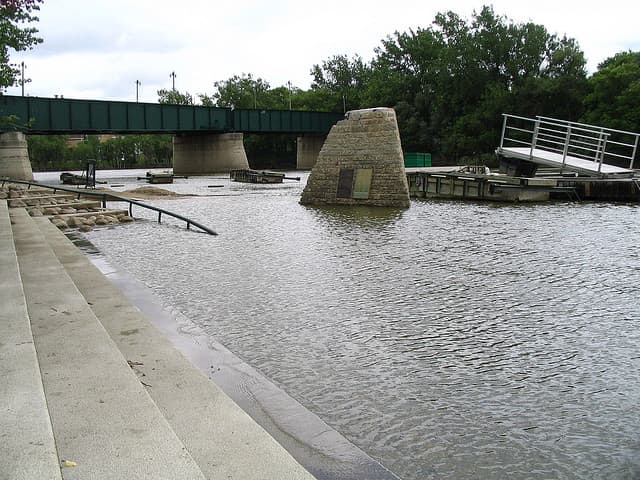Emergency Channel Construction Proceeding to Lower Lake Manitoba, Lake St. Martin Levels
OutdoorHub 07.27.11

The Manitoba government will start construction on an emergency channel out of Lake St. Martin immediately, and Lake Manitoba outflows through the Fairford River water control structure will be unrestricted throughout the winter, as recommended by independent engineering firms KGS and AECOM. If construction can be completed by this fall, levels on both lakes would be lowered before spring run-off begins, reducing the likelihood of flooding in 2012.
Several different options were examined by KGS and AECOM with technical support from Manitoba Infrastructure and Transportation and Manitoba Water Stewardship. The option to quickly build an emergency channel that will allow for ongoing maximum flows through the Fairford River water control structure was assessed as the best option to provide emergency relief from high lake levels, and protect homes and communities along lakes Manitoba and St. Martin. The assessment is based on data which includes site visits, topographic analysis, seismic bedrock investigation, aerial photography, LIDAR surveying and geotechnical work.
The Lake St. Martin emergency channel will go from Lake St. Martin to Big Buffalo Lake. The channel is expected to handle flows of up to 9,000 cubic feet per second (cfs), depending on lake levels when the channel becomes operational. From Big Buffalo Lake, the water will follow natural channels to the Dauphin River. Both Lake Manitoba and Lake St. Martin currently drain into Lake Winnipeg through the Dauphin River. This emergency channel is expected to affect Lake Winnipeg’s North Basin levels by less than one inch, which is approximately 0.5 per cent of Lake Winnipeg’s inflows. Lake Winnipeg levels are expected to drop by two feet before the Lake St. Martin channel becomes operational and Lake Winnipeg’s flood risk will not be affected by the operation of the channel.
The five-mile emergency channel is expected to be 300 ft. wide and up to 25 ft. deep. Details of the construction project are being finalized and consultation with the affected First Nations communities will continue as the project proceeds on an emergency basis. It is expected to involve the excavation of as much as 2.5 million cubic metres of earth, 50 pieces of heavy equipment and 150 staff. Preliminary work has already started at the construction site.
Depending on progress of the construction of the emergency channel, additional construction of a bypass channel around the north side of the Fairford River water control structure will be undertaken to further reduce Lake Manitoba levels, as recommended by the engineering firms. This would also require expansion of the newly built Lake St. Martin emergency channel to ensure no net addition of water to Lake St. Martin.
Manitoba Water Stewardship estimates building the emergency channel and maintaining maximum flows at the Fairford River water control structure all winter would bring the chance of Lake Manitoba staying below 814 ft. in 2012 up to 90 per cent and Lake St. Martin’s chance of staying below 802 ft. to 98 per cent. Construction of a Fairford River bypass channel would increase the chance of Lake Manitoba staying below 814 ft. in 2012 to 98.7 per cent.

